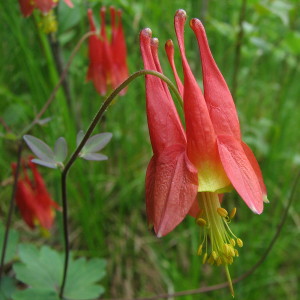 Last year at about this time, my daughter and I sought out some COVID lockdown relief in a park that boasts the highest elevation in our state. As we indulged in that relief, we spotted a number of interesting wild plants, including the star of the wildflower show, pink lady’s slipper orchid or Cypripedium acaule.
Last year at about this time, my daughter and I sought out some COVID lockdown relief in a park that boasts the highest elevation in our state. As we indulged in that relief, we spotted a number of interesting wild plants, including the star of the wildflower show, pink lady’s slipper orchid or Cypripedium acaule.
Fast forward to this year and we decided to celebrate emergence from the pandemic with a trip back to the same park to rediscover the lady’s slippers. We eventually found one, but only after seeing something equally dramatic and beautiful—a large stand of eastern red columbine, or Aquilegia canadensis, in full bloom.
Most plant lovers are familiar with cultivated columbine, spring-flowering biennial or perennial plants that stand a foot or more in height with lobed green leaves and drooping bell–shaped or cylindrical blooms accented with long, projecting “spurs”. The market is full of interesting species and varieties, in white, yellow, pink, blue-purple, purple and combinations of those colors. “Granny’s bonnet” types have fussy double flowers, each one looking like a piece of millinery that would look perfectly appropriate on the head of Dolly Madison.
I would like to say that my garden is home to a kaleidoscope of columbine colors, but no matter what I plant, 90 percent of my columbines pop up each spring with blue-purple flowers. Since I can’t do anything about this, I take full credit when people talk about the dramatic color repetition in the beds.
Besides, I am not surprised at this one-color phenomenon. About the same percentage of my Spanish bluebells—Hyacinthoides hispanica—arise from the earth each year with pink blooms.
I chalk the color conundrum up to the fact that columbines tend to self-seed liberally and the blue-purple strain has obviously won the lottery for genetic dominance on my property.
Eastern red columbine, on the other hand, is almost always an unabashed red–deeper or less intense depending on location, light and a host of other factors. The red petals and upturned spurs are accented by a mass of yellow stamens, making the flowers look like small firecrackers.
We found the stand of wild columbine on the edge of a wooded area, high up on a rocky slope. With a light breeze blowing, the flowers seemed to dance along the roadside.
The location was typical of conditions favored by Aquilegia canadensis, the only columbine native to the eastern United States and Canada. While the “canadensis” in the species name makes it sound like an habitué of the Great White North, its range is much larger—from Nova Scotia all the way south to Florida and westward to a theoretical boundary that runs from Saskatchewan down to Texas.
Sometimes looking at a flower close up, especially a relatively complicated one like eastern red columbine, makes you wonder how any creature accomplishes the necessary task of pollination. Hummingbirds, with their ability to sip nectar, pollinate and hover in mid-air all at the same time, are one of the species that pollinates wild columbines. The plants may also self pollinate, but I like the thought of hummingbird visits.
One of the lovely things about columbine, both wild and domesticated, is that the foliage is lovely all by itself. Masses of three-lobed leaves cover the ground before, during and after the flowering season. Sometimes they are attacked by leaf miners, whose activity is marked by white squiggles on the leaves, but the assaults are not serious.
You should never transplant a red columbine, or any other wild plant, from its natural setting. However, you can purchase plants for your home garden. They work well in native plant gardens, pollinator beds, rock gardens or even containers. Once established, native columbines can also withstand some dryness,
Left to their own devices, red columbine will form segmented brownish seed pods after the flowers depart. These turn dry and papery before disgorging the seed. After overwintering, you will likely see small plants in spring.
It is always a joy to round a corner in a park or other wild area and discover a stand of wildflowers. I recommend nature hikes, especially in spring, for this purpose. If you want a bit of that joy in your own garden, you can purchase Aquilegia canadensis from Bluestone Perennials, 7211 Middle Ridge Rd. Madison, OH 44057; (800) 852-5343; www.bluestoneperennials.com. Print catalog available.
